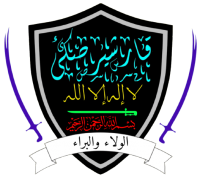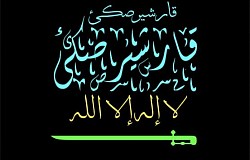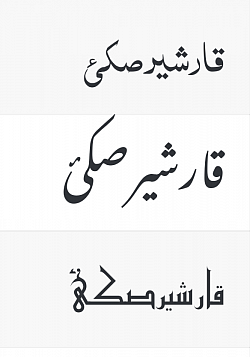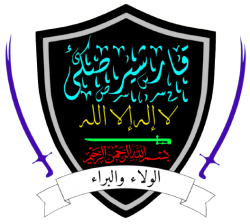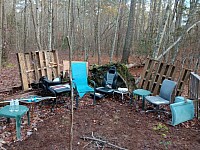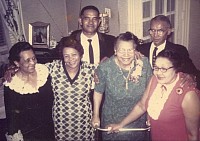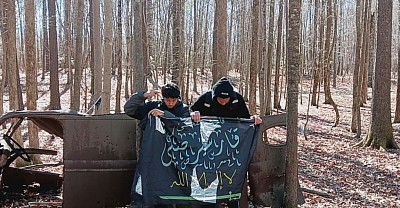The Qarsherskiyan people
Languages spoken by Ethnic Qarsherskiyans in the Eastern USA:
The ethnic Qarsherskiyan tribe speaks a variety of different languages, with some being more or less common among tribal members.
1.) English (international communication)
2.) Qarshkī Creole (local community leaders)
3.) Tidewater Pidgin (local community sages/scholarly discussion)
Arabic (religious uses)
4.) Persian (poetry uses)
5.) Russian (used for transactions and trade sometimes on the Ethnic Qarsherskiyan Trade Routes)
6.) Turkish (used for historical reasons, especially Ottoman Turkish)
7.) Kurdish
8.) Indonesian & Malay (used for nasheeds)
9.) Urdu (poetry uses)
10.) Cherokee language
11.) Navajo language (encryption)
12.) Other languages.
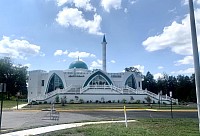
Masjid Al Nabi, a mosque in Chantily, Virginia, has some ethnic Qarsherskiyans who attend prayer there sometimes.
Ethnic Qarsherskiyans, their history, and the cultural genocide against Qarsherskiyan people
Southeastern Virginia has an estimated 397,661 ethnic Qarsherskiyan people as of 2023.
In the 1500s the first Muslims arrived on the Virginia Peninsula. By the 1760s, future Governor of Virginia and U.S. President Thomas Jefferson bought an English translation of the Quran while studying law. At the time, Muslims were known as "Mahometans," in Virginia and an estimated 20 percent of enslaved Africans were Muslim. Three years after the end of the Revolutionary War, Thomas Jefferson's 1779 "Bill for Establishing Religious Freedom", was passed by the Virginia General Assembly and became law in 1786. The new law guaranteed freedom of religion to people of all religious faiths, including Muslims. Research indicates that some of Mount Vernon's enslaved workers in Virginia were practicing Muslims and adhered to Islamic tradition.[see source] By the time slavery was abolished, many freed and escaped Black Muslims on the Virginia Peninsula formed what is today called the Proto-Qarsherskiyan people group by intermixing with Muslims from immigrant backgrounds who came from Asia, Africa, and Europe as well as Native American converts. Beginning in the 20th century, Muslims have been a rapidly growing religious group throughout the state through immigration and remain a "major driver of Virginia's religious diversity."[source 1][source 2] By the 1950s, some Muslims in Virginia became affiliated with the Nation of Islam, a Black-oriented form of Islam.[source 1] Virginia has had many Muslim service members and veterans. By the 1970s, a cohort of the first Muslim cadets graduated from the Virginia Military Institute.[source 1] In the late 1970s, U.S. Marine Douglas Burpee was accepted into the Officers Candidates' School in Quantico, Virginia. By the end of his military service, Colonel Burpee was the highest-ranking Muslim in the U.S. Marine Corps.[source 1] In 1991 the idea of a non-hostile Islamic State in North America for the community now known as Ethnic Qarsherskiyans took root. The movement failed but in 2019 notebooks from an unknown date detailing the movement were found hidden inside walls of homes in Ohio being renovated and were given to local Muslims who grew inspired and revived the movement. The descendants of the Proto-Qarsherskiyans were named ethnic Qarsherskiyans after Qarsherskiy and their ancestors obtained the term Proto-Qarsherskiyans because of this.
In 2023, many Qarsherskiyans on the Virginia Peninsula are outraged after a Newport News police officer allowed his wife to harass a group of Muslims at a table in a bar and call them the “terrorist table,” eluding to the stereotype that all Muslims are terrorists because of the 9/11 attacks over 2 decades before. When politely confronted, he made death threats and showed his gun and committed murder.
This is part of the ongoing cultural genocide against ethnic Qarsherskiyans. The Qarsherskiyan Cultural Genocide is perpetrated by both the Left and the Right and isn’t a physical genocide but is more of an erasure of the history, culture, and the Qarshkī language of the ethnic Qarsherskiyan people. While cultural genocides aren’t usually involving mass killings like physical genocides, it has caused a few unjust deaths of Qarsherskiyan and other people who appeared to be Islamic or Muslim in the region of South East Virginia, the Lake Erie Coast, and the Appalachian mountains of West Virginia and Maryland, where the Qarsherskiyan people live in highest concentrations.
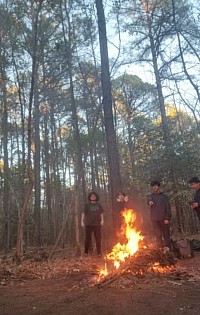
قبيلة قارشيرصكئان العرقية هي قبيلة معزولة ثلاثية العرق، يعني هي خليط من الأصل الأمريكي الأصلي والحبشي والأوروبي اللي تم خلطه ليشكل عرقية جديدة. قبيلة قارشيرصكئان العرقية لها تاريخ طويل يمتد إلى ٥٠٠ عام يعود إلى أول اتصال بين الأوروبيين الإيبيريين والمسلمين المور واليهود والأمريكيين الأصليين، مع رحلة كريستوفر كولومبوس. قبيلة قارشيرصكئان العرقية هي واحدة من القبائل الرئيسية الثلاثة عشر للقريول سويتغوم. قبائل القريول سويتغوم هي مجموعات من الشعوب ثلاثية العرق في أمريكا الشمالية الشرقية ذات تاريخ وثقافة وأسماء عائلية مماثلة. بعض قبائل القريول سويتغوم الأخرى هي شعب لومبي في مقاطعة روبسون، نورث كارولينا، الولايات المتحدة، والميلنجون من جبال أبلاشيان الوسطى والجنوبية. قبيلة قارشيرصكئان العرقية هي في الغالب مسلمة العليئية، طريقة صوفية داخل الإسلم الشيعي الزيدي، والتي تتميز لأن معظم الطرق الصوفية تقع داخل الإسلم الشيعي الجعفري أو الإسلم السني. ثقافة قبيلة قارشيرصكئان العرقية تتأثر بشكل كبير بالمعتقدات العليئية وتفسيرات النصوص المقدسة.
أهل القارشيرصكئ: قارشيرصكئً في قارشيرصكئان
قبلية قارشيرصكئان العرقية هي مجموعة معزولة ثلاثية العرق، مما يعني أنها مزيج من الأصل الأمريكي الأصلي والأسود والأوروبي الذي تم مزجه لتشكيل عرقية جديدة. تتمتع قبلية قارشيرصكئان العرقية بتاريخ يمتد إلى ٥٠٠ عام يعود إلى أول اتصال بين الأوروبيين الإيبيريين والمسلمين المور واليهود والأمريكيين الأصليين، مع رحلة كريستوفر كولومبوس. تعد قبلية قارشيرصكئان العرقية واحدة من القبائل الرئيسية الثلاثة عشر للقريول سويتغوم. قبائل القريول سويتغوم هي مجموعات من الشعوب ثلاثية العرق في أمريكا الشمالية الشرقية ذات تاريخ وثقافة وأسماء عائلية مماثلة. بعض قبائل القريول سويتغوم الأخرى هي شعب لومبي في مقاطعة روبسون، نورث كارولينا، الولايات المتحدة، والميلنجون من جبال أبلاشيان الوسطى والجنوبية.
قبلية قارشيرصكئان العرقية هي في الغالب مسلمة العليئية، طريقة صوفية داخل الإسلم الشيعي الزيدي، والتي تتميز لأن معظم الطرق الصوفية تقع داخل الإسلم الشيعي الجعفري أو الإسلم السني. ثقافة قبلية قارشيرصكئان العرقية تتأثر بشكل كبير بالمعتقدات العليئية وتفسيرات النصوص المقدسة.
जातीय क़र्शरस्कियन जनजाति क्या है?
जातीय क़र्शरस्कियन जनजाति क्या है?
कार्शीर्स्की जनजाति एक त्रिश्रेणी जातीय समूह है, जिसका अर्थ है कि वे मूल अमेरिकी, काले और यूरोपीय वंश के मिश्रण हैं जो एक नई जातीयता बनाने के लिए मिले हैं। कार्शीर्स्की जनजाति का 500 साल का इतिहास है, जो पहले संपर्क से लेकर इबेरियन यूरोपीय, मूरिश मुसलमानों और यहूदियों, और मूल अमेरिकियों के बीच क्रिस्टोफर कोलंबस की यात्रा तक है। कार्शीर्स्की जनजाति 13 मुख्य स्वीटगम क्रियुल जनजातियों में से एक है। स्वीटगम क्रियुल जनजातियाँ पूर्वी उत्तरी अमेरिका में समान इतिहास, संस्कृति और उपनाम वाले त्रिश्रेणी लोगों के समूह हैं। स्वीटगम क्रियुल की अन्य जनजातियों में रॉबेसन काउंटी, नॉर्थ कैरोलिना, यूएसए के लुम्बी लोग और मध्य और दक्षिणी अप्पलाचियन पहाड़ियों के मेलंजंस शामिल हैं।
Qarsherskiy in Hindi is:
कार्शीर्स्की
Ethnic Qarsherskiyan tribe
कार्शीर्स्की
Кто такие этнические племя Карширскиан?
Племя этнических Карширский является изолированной группой трёх рас, то есть они представляют собой смесь коренных американцев, чернокожих и европейского происхождения, смешавшихся для образования новой этнической группы. Племя этнических Карширский имеет 500-летнюю историю, восходящую к первому контакту между иберийскими европейцами, мавританскими мусульманами и евреями, и коренными американцами, во время путешествия Христофора Колумба. Племя этнических Карширский является одним из 13 основных племен Свитгум Криюл. Племена Свитгум Криюл представляют собой группы трёх расовых народов Восточной Северной Америки с подобной историей, культурой и фамилиями. Другие племена Свитгум Криюл включают народ Лумби из округа Робесон, штат Северная Каролина, США, и Мелунжонов из центральной и южной части Аппалачских гор.
Sacred symbols of the Ethnic Qarsherskiyan Tribe

A wild Dwarf Palmetto Palm (Sabal minor) grows on the banks of a creek on the Virginia Peninsula. These palms are being documented by Ethnic Qarsherskiyans on iNaturalist as part of a project of iNaturalist collaborating with indigenous communities to learn more about the natural world.
There are many symbols that the Ethnic Qarsherskiyan Tribe considers sacred. Carolina Parakeets (Conuropsis carolinensis) are one sacred symbol that represents the Qarsherskiyan people. There is also the Trifoliate Orange, a replacement of the sacred Semitic Etrog fruit (Citrus medica), with one leaflet for each of the three races that mixed to create Qarsherskiyans (White, Black, and Native American). One sacred symbol of the Qarsherskiyan tribe is the Dwarf Palmetto Palm (Sabal minor), which is the only native palm tree in the state of Virginia. Sabal minor naturally occurs on the lower Virginia Peninsula and across the James River in the Great Dismal Swamp, as well as the strip of land between the Great Dismal Swamp and the shores of the Atlantic Ocean at Sandbridge and Virginia Beach. 4 clusters are known to grow deep in the woods of First Landing State Park and they also extend South to Elizabeth City in North Carolina. The Sabal minor or Dward Palmetto's native range in southeast coastal Virginia and the Elizabeth city area of North Carolina is discontinuous from the rest of its range's extent further South in other parts of North Carolina and the Southern USA, helping to create biodiversity. This biodiversity is being destroyed as the last few remaining native Dwarf Palmettos (Sabal minor) in Virginia get cut down for suburban expansion and Dwarf Palmetto (Sabal minor) from out of state is planted in gardens, cross pollinating with the wild population and erasing genetic differences, effictively starting an irreversible proccess of homogenization. The Qarsherskiyan Tribe, like the Chesapeake and citizens of the Powhatan confederacy, have a tradition of making matts and baskets from the fronds of these palms. Dwarf Palmetto (Sabal minor) is considered sacred by Qarsherskiyan people in coastal Virginia, particularly by Aliyite Muslims in the tribe, because the palms are the only native palm in Virginia, making them the closest thing to the date palms the prophet Muhammad (ص) planted, to be available in colonial Virginia.
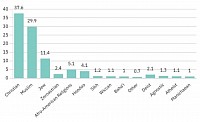
A religious graph showing the percentage of religious adherance of each religious group within the Ethnic Qarsherskiyan Tribe.
Religious beliefs of the Ethnic Qarsherskiyan Tribe
The Ethnic Qarsherskiyan Tribe has quite a few different religious groups within it, Muslims being (29.9%) and the Qarsherskiyan Manichaens (1%), a neo-Manichaen religious movement with several hundred followers. Christians make up (37.6%) of all Qarsherskiyan people while Jews make up another 11.4% of the Ethnic Qarsherskiyan Tribe. Zoroastrians make up 2.4% of Ethnic Qarsherskiyan people. Another 5.1% of the Qarsherskiyan Tribe adhere to various other Afro-American religions such as Santeria, Umbanda, Candomblé, and different religions that are branches of Ìṣẹ̀ṣe and other African traditional religions. 4.1% of Qarsherskiyan people follow Voodou/Voodoo/Vodun. Sikhs constitute 1.2% of Qarsherskiyan people. 1.1% of the Qarsherskiyan people are Wiccans. Baha'is make up 1% of Qarsherskiyan people. 0.7% of Qarsherskiyans follow various other religions. 2.1% of Qarsherskiyans are Deists and another 1.3% are Agnostic. Atheists only make up 1.1% of the Qarsherskiyan people - but still are close to matching Qarsherskiyan Manichaens who make up 1% of the Qarsherskiyan population.
Kiderelloz Ceremony

The pine forests of coastal Virginia and coastal North Carolina are considered to be one of the oldest parts of the Mezhrevande, the Ethnic Qarsherskiyan homeland. Here, usually in February but sometimes in March during colder years, Qarsherskiyan people of all religions celebrate Kiderelloz. Kiderelloz is not religious, but a cultural festival held by Ethnic Qarsherskiyans. During Kiderelloz, Qarsherskiyan people eat snacks in the woods, tell tales of the ancestors and folklore, and walk or run in counterclockwise circles around a bonfire, taking jumping through and over it, which symbolizes passing into Spring and leaving Winter behind.
Kiderelloz is a Qarsherskiyan festival celebrating the coming of Spring and a new year. Although New Year's Eve on the Gregorian Calendar is January 1st, Kiderelloz celebrates the New Year as the coming of Spring, and is usually celebrated in February and March along the Atlantic coast, and later further inland. The first Spring flowers are used as decoration and Qarsherskiyan people of all religions gather at bonfires, usually in large dirt bare clearings in the forests, and surround a large bonfire, where stories reflecting on the past and wishing for a better future are told, often involving folklore and stories of the ancestors. People take turns running towards and jumping over the hot fire, which symbolizes entering a New Year, having past worries and troubles being burned off of one's self, and cleansing one's self for a fresh start to a new growing season and year cycle. Qarsherskiyans use the Gregorian Calendar, like most Americans, but many write the Day-Month-Year format unlike in mainstrean American society which uses Month-Day-Year. Muslim Qarsherskiyans also use the Islamic Hijri Calendar and Orthodox Christian Qarsherskiyans also use the Julian Calendar. Baha'is and adherents to other religions all use their own respective religion calendars alongside the Gregorian Calendar. Many Qarsherskiyan's make Qarsherskiyan Zikr during Kiderelloz. Qarsherskiyan Zikr involves repeating words over and over to remember God, or to remember certain prophets and saints too, depending on religion and denomination. Most Qarsherskiyans repeat "La Ilaha Ilah Allah" meaning "There is only one God" or "There is no God but God." Qarsherskiyan Muslims add "Muhammad Rasool Allah" meaning "Muhammad is the messenger of God" as well as often adding "Allahumma Sali Aala Muhammadin Wa Aala Aale Muhammad" and also "Ali(yun) Wali Allah" for many Qarsherskiyan Shia Muslims. Many Qarsherskiyans repeat "Allah Allah" over and over until they go into a trance and it sounds like "Alala ala alala ala." Qarsherskiyan Zikr is often paired with clapping and stomping in time with a rhythm and running or walking in circles. Qarsherskiyan Zikr is influenced by the Nigerian and West African part of Qarsherskiyan people's mixed-race ancestry, but also from Kishiev Kunta-Haji, who is revered by Qarsherskiyans from the Aliyite Shia Sufi Order and Ingush, Circassian, Chechen, Dagestani, and other Vainakh peoples from the Qadriyya and Naqshbandiyya Sunni Sufi Orders.
History of the Ethnic Qarsherskiyan Tribe
The history of the Ethnic Qarsherskiyan Tribe is traced by some to the late 1400s during the era of Christopher Columbus, while others trace it back to the founding of Jamestown. Many trace it back to the first Muslims in North America.
Starting around 1513, Spanish colonizers began bringing enslaved African Muslims to what is now Florida, Mississippi, Alabama, Louisiana, Texas, New Mexico, and other parts of the USA that were formerly controlled by the Spanish empire. Mustafa Azemmouri, often called Estevanico, was sold into slavery in 1522 by the Portuguese. Spanish conquistador Andrés Dorantes de Carranza ended up keeping Estevanico enslaved, and Estevanico became one of the first Africans to step foot on North American soil. He explored Florida, the Gulf Coast, and even the American Southwestern deserts. The USA didn't even exist back then. Not even Jamestown had been founded yet. Estevanico would end up forming amazing relationships with Native American tribes in Texas, becoming a Medicine man, and even traveled so far as to see the Pacific Ocean, all before Jamestown had ever existed or been founded. An African Muslim man did all this and more long before the American ideology of manifest destiny carried Anglo-American settlers to the Pacific coast, as they hadn't even arrived to successfully colonize what would become USA.
Islam has been part of the religious make-up of America since the first colonial settlers arrived in North America. African Muslims played key roles in the founding of the United States, mapping it's borders and fighting against British rule. Around 1 in 5 of all African people brought to the USA via the transatlantic slave trade were adherentd to Islam, and nearly all Black Americans who live today are descended from one of these African Muslims. One famous Black Muslim slave was Abdul Rahman Ibrahima.
Abdul Rahman Ibrahima ibn Sori was a Fulani man born in West Africa in 1762. Ibrahima left Futa in 1774 to study in Timbuktu, Mali. He was kidnapped at the age of 26 in 1788 and sold to British slave traders stationed on the River Gambia. Ibrahima was eventually sold to Thomas Foster in Natchez, Mississippi, becoming first a field hand, then rose to become the plantation overseer. He was known as the “Prince among the Slaves.” As a young man, Ibrahima was a Prince and a captain of his father’s army. In 1794, Abdur Rahman married a woman named Isabella, having a large family, nine children, 5 sons and 4 daughters. Ibrahima was known for being a knowledgeable and devout Muslim. In 1828 Ibrahima raised 3,500 dollars touring the northeast and Cincinnati to free his family. In February 1829, Ibrahima and his wife sailed to Africa. Shortly after arriving in Liberia Abdur-Rahman got cholera and died six weeks later. The following year, Thomas Foster also died and his heirs sold 2 of Rahman’s children and 5 of his grandchildren to the American Colonization Society, which in turn reunited them with Isabella in Liberia. Ibrahima’s sons Lee, Simon, Simon’s wife Hannah, and their 5 children, Simon, Susan, Cresy, Nancy, and Hester all made it to Liberia.
Omar Ibn Said was a Black Muslim and was born around 1770 in Futa Toro by the River Senegal.
He was raised by his uncle after his father died when he was only 5 years old.
He became a devout Muslim and made the Hajj pilgrimage to Mekkah. He went there on foot!
Omar Ibn Said married and had a son before being abducted and sold into slavery in America when he was about 40 years old.
Omar was enslaved for 56 years and wrote at least 15 surviving texts in Arabic, including letters, Islamic verses, and his autobiography.
He died in 1864 and he was subsequently buried in Bladen County, North Carolina, USA during the time of the Confederate States.
Omar Ibn Said became famous for writing in Arabic on the walls of his jail cell, which contradicted the belief that enslaved Africans were illiterate. His autobiography is the only known surviving American slave narrative written in Arabic by an African while he was still enslaved in what would become the USA. Although it is said that ibn Said converted to Christianity on December 3, 1820, his conversion to Christianity was a cover-up, and there were devotional praises to Muhammad written in his Bible, and also a card dated 1857 on which he wrote Surat An-Nasr, a short surah (chapter in the Quran) which refers to the conversion of non-Muslims to Islam 'in multitudes.' The back of this card contains another person's handwriting in English misidentifying the surah as the Lord's Prayer and attesting to Omar's status as a "good Christian". While others writing on Omar's behalf identified him as a being a Christian, his autobiography and other writings offer more of an ambiguous position. In the autobiography, he still praises Muhammad; he references "Jesus the Messiah", the same way as the Quran's descriptions of Jesus (who is called المسيح 'the Messiah' 11 times in the Quran), and describing Jesus as 'our master' (سيدنا sayyidunā) employ the typical Islamic honorific for prophets and is not to be confused with Lord (ربّ rabb); description of Jesus as 'bringing grace and truth' (a reference to John 1:14) is equally appropriate to the conception of Jesus in Islam. It was most likely that he stayed a Muslim his whole life but was believed to have converted to Christianity by people at the time when he simply loved Jesus since he was considered a prophet in Islam. This was stated in his auto-biography.
African Muslims helped the British and their colonies militarily expand West from the East Coast. During the a war called the French And Indian War, with "Indian" being a term referring to Indigenous Americans, the British and their American colonies had a war with New France, the French colonies in North America. The British succeeding in gaining control of territory the French formerly held, with different Native American tribes aligning with different sides. British Major-General Edward Braddock was defeated in 1755 at Fort Duquesne. The British had to retreat to the East, building a line of forts running North to South along the new battleground in what is now Huntington County, Pennsylvania. One of these forts, called Fort Shirley, had to be quickly abandoned. It wasn't abandoned before a Blacksmith made a small circular charm with the phrase "there is no God except Allah" on it in Arabic. This proves that Muslims served in the British military during the French And Indian War.
Impressively, during the 1730s, Ayuba Suleiman Diallo wrote multiple copies of the Quran, which he had completely memorized, and wrote from memory! He used these for devotion and education.
Ayuba was purchased by Mr Tolsey from Kent Island, Maryland. Ayuba was put to work in tobacco fields but was found to be unsuitable for such work. He was then placed in charge of livestock. While in enslaved in America, Ayuba used to go into the woods to pray. However, one day he was humiliated by a child while praying and ran away in 1731, and was captured and imprisoned at the Kent County Courthouse. Unfortunately, Ayuba's reason for escape was not understood until an African translator was located. Able to communicate his needs, Ayuba's owner set aside a special area for him to offer undisturbed prayers to Allah upon his return to being a slave. It was at the courthouse that he was discovered by lawyer and Anglican priest Thomas Bluett, of the Society for the Propagation of the Gospel, travelling for business purposes.
Thomas was impressed by Ayuba's ability to write in Arabic. Bluett wrote the following:
"Upon our Talking and making Signs to him, he wrote a Line or two before us, and when he read it, pronounced the Words Allah and Mahommed; by which, and his refusing a Glass of Wine we offered him, we perceived he was a Mahometan, but could not imagine of what Country he was, or how he got thither; for by his affable Carriage, and the easy Composure of his Countenance, we could perceive he was no common Slave."
When another African who spoke the language called Wolof, of a neighbouring African ethnic group, translated for him, it was discovered that he was of aristocratic blood. Encouraged by the circumstances, Tolsey allowed Ayuba to write a letter in Arabic to West Africa to send to his father. Eventually, the letter reached the office of James Oglethorpe, Director of the Royal African Company. After having the letter authenticated by John Gagnier, the Laudian Chair of Arabic at the University of Oxford, Oglethorpe purchased Ayuba for £45.
Muslims also fought on both sides of the Revolutionary War, with many Islamic names appearing on the military muster roles. Patriots such as Bampett Muhamed, Joseph Saba, and Joseph Benhaley, also known as Yusuf Bin Ali, the progenitor of the Krioturks / Sumter Turks tribe of Sweetgum Kriyul people. These men often distinguished themselves on the battlefield and earned high ranking and honorable positions.
During the Civil War, union captain Moses Osman became the highest ranking known Muslim in that conflict.
At the first African Church in Savannah, Georgia, USA, some African Americans secretly practiced Islam, while outwardly identifying as Christians and practicing a syncretic blend of the two religions that most White Christians just saw as Black Christians. Surah Al-Nas was etched into a pew at that church. Surah Al-Nas is a verse from the Quran. This final chapter of the Quran is used for protection, in this case it was used by early Black Americans as protection against their enslavers.
Interviews done in the 1930s and 1940s with formerly enslaved people and their descendants are filled with references to Islamic religious practices. One common account told time and time again is about prayer beads, called tasbih, and prayer mats. Katie Brown, great granddaughter of Belali Mohamet, who was enslaved on the island of Sapelo in coastal Georgia on the Gullah Geechee coast, recalls quote:
"Belali and his wife, Phoebe, pray on the bead. They bow to(wards) the sun and have a little mat to kneel on. The bead is on a long string. Belali, he'd pull bead, and he say 'belambi hakabara Muhamadu.' Phoebe, she'd say, 'ameen... ameen.' "
The Kaaba, the direction in which Muslims pray towards, would have been East of West Africa, and is East - Northeast of the US East Coast. While facing the Qiblah, the direction of Mekkah, which all Muslims face whilst praying, the Fajr prayer would have occurred before sunrise, with enslaved Muslims facing East towards the growing light pre-dawn.
Muslims may have been able to pray in USA in secret, but when caught, may face humiliation.
Ayuba Suleiman Diallo was pelted with dirt by a White boy in Kent Island, Maryland. That is the humiliating event which caused him to run away.
An unknown Moorish person enslaved in Louisiana confirmed this hardship in 1822, when they, quote:
"lamented that is situation as a slave in America prevents him from obeying the dictates of his religion."
Salih Belali and Belali Mohamet and other enslaved Muslims on the coastal barrier islands between Virginia Beach and Amelia Island, Florida have passed down through generations the Islamic Sufi practice of Zikr. Black American Christians, especially from the Gullah Geechee community, practice Ring Shout, a devotional form of religious dancing involving rotating in counterclockwise circles, like Hajj pilgrims do around the Kaaba in Mekkah, and clapping their hands and singing rhythmically. Aliyite Muslims from the Ethnic Qarsherskiyan Tribe also have a similar practice of standing in a ring or circle as a group, swaying side to side while singing devotional poetry, and walking or running in counterclockwise circles while stomping the feet, clapping the hands, and singing to a rhythm, often going into a trance and experiencing an ecstatic state.
The WPA narratives also contain references of rice cakes called Sarakah. The name comes from the Arabic term Sadaqah, which means to give charity. Muslims often would give such rice cakes back in Africa to poor people during Ramadhan as a charitable donation.
Early blues singers, like those recorded by ethnomusicologist Alan Lomax in "Levee Camp Holler," employed singing Styles reminiscent of the Islamic call to prayer called the Azaan.
Ring Shout has the word Shout, which has been theorized to have actually come from Arabic "Shāwt" which means to walk a single walk about.
The traces of African Muslims in early America remain today with all of the previously mentioned knowledge and history. The Qarsherskiyans descended from the Black Muslims brought to the Americas for slavery, with one in every 5 Black people brought to the USA being a Muslim. Over many generations, interracial relationships between these Black people and poor White people and Native Americans have created what would become the Ethnic Qarsherskiyan Tribe.
The earliest Black ancestors of the Qarsherskiyans lived, not in the 1700s, but as early as 1619 in the Tidewater colonies. By the time they met with the first settlers in Ohio and what is now West Virginia, the Qarsherskiyan community was already more than a hundred years old. Qarsherskiyans are not originally the offspring of White plantation owners and Black females slaves, although many people who are the product of these relationships did marry into the Qarsherskiyan community later on. The original African ancestors of Qarsherskiyan were never slaves, but former Black servants freed from indentured servitude just like White servants, usually before 1720. Other African ancestors of the Qarsherskiyans either purchased their freedom from slavery or were freed upon the deaths of their White owners. But the original ethnogenisis population of the Black ancestors of the Qarsherskiyans were free by 1720. Most often, they married White women in Virginia and other southern colonies. Understanding the status of the African ancestors of Qarsherskiyans throughout different time periods is critical to understanding Qarsherskiyan people's history.

